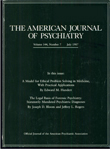Effect of Flumazenil in Lactate-Sensitive Patients With Panic Disorder
Abstract
OBJECTIVE: Flumazenil is a benzodiazepine receptor antagonist that has been reported to provoke panic attacks in patients with panic disorder. This study was undertaken to compare the effects of flumazenil and sodium lactate, the most widely studied panic provocation agent. METHOD: Ten patients with panic disorder were given infusions of saline, sodium lactate, and flumazenil in randomized order. Panic attacks, psychopathological changes, heart rate, and cortisol and ACTH secretion were recorded. RESULTS: Eight of the 10 patients experienced a panic attack after sodium lactate, but none did after flumazenil or saline. Cortisol and ACTH secretion were not enhanced by any of the treatments. Sodium lactate increased heart rate, whereas flumazenil had the opposite effect. CONCLUSIONS: These findings do not lend support to the view that the benzodiazepine receptors of lactate-susceptible patients with panic disorder are hypersensitive and that flumazenil can therefore act as an inverse agonist.



